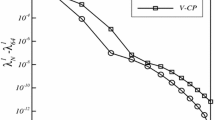Abstract
This paper presents a fast iterative algorithm for the solution of a finite difference approximation of the biharmonic boundary value problem on a rectangular region. For solving this problem, the matrix decomposition algorithm is efficiently applied to the semi-direct method which essentially treats the biharmonic equation as a coupled system of Poisson equations. Assuming anN×N grid of mesh points, the number of operations required for one iteration and for the solution terminated by 0 (N −2) is 0 (N 2) and 0 (N 5/2 log2 N), respectively. ForN 2 processors, the parallel version of this algorithm would require 14 log2 N steps per iteration. Both results are better than those known. A numerical experiment in a serial computation is also given.
Zusammenfassung
In diesem Artikel wird ein schneller Algorithmus für die Lösung von Differenzen-Approximation des ersten Biharmonischen Randwertproblems auf einem rechtwinkligen Gebiet dargestellt. Für die Lösung dieses Problems wird der Algorithmus der Matrix-Dekomposition in der halbdirekten Methode, die die Biharmonische Gleichung als ein gekoppltes Paar von Poisson-Gleichungen behandelt, effektiv verwendet. Unter der Annahme einesNxN Netzes ist die Anzahl der erforderlichen arithmetischen Operationen für eine Iteration bzw. für eine Lösung, die mit Genauigkeit 0 (N −2) bestimmt wird, 0 (N 2) bzw. 0 (N 5/2 log2 N). Die parallele Version dieses Algorithmus fordert mitN 2 Prozessoren 14 log2 N Schritten für eine Iteration. Beide Resultate sind besser als bis jetzt bekannte Resultate. Für die sequentielle Berechnung wird ein numerisches Experiment angegeben.
Similar content being viewed by others
References
Ehrlich, L. W.: Solving the biharmonic equation as coupled finite difference equations. SIAM J. Num. Analys.8, 278–287 (1971).
Greenspan, D., Schultz, D.: Fast finite-difference solution of biharmonic problems. Comm. ACM15, 347–350 (1972).
Ehrlich, L. W.: Solving the biharmonic equation in a square: A direct versus a semidirect method. Comm. ACM16, 711–714 (1973).
Mc Laurin, J. W.: A general coupled equation approach for solving the biharmonic boundary value problem. SIAM J. Num. Analys.11, 14–33 (1974).
Buzbee, B. L., Dorr, F. W.: The direct solution of the biharmonic equation on rectangular regions and the Poisson equation on irregular regions. SIAM J. Num. Analys.11, 753–762 (1974).
Sameh, A. H., Chen, S. C., Kuck, D. J.: Parallel Poisson and Biharmonic Solvers. Computing17, 219–230 (1976).
Vajteršic, M.: An algorithm for the solution of biharmonic equation. Rep. “Theoretical problems of the implementation of numerical algorithms on higher generation computers”. UTK SAV Bratislava, 1978. (In Slovak.)
Buzbee, B. L., Golub, G. H., Nielson, C. W.: On direct methods for solving Poisson equations. SIAM J. Num. Analys.7, 627–656 (1970).
Varga, R. S.: Matrix iterative analysis. New York: Prentice-Hall 1962.
Václavik, P.: An algorithm for the solution of a special three-diagonal linear equation system. Acta Cybernetica3, 99–114 (1976). (In Slovak.)
Buneman, O.: A compact non-iterative Poisson solver. Stanford Univ. Inst. for Plasma Res., Stanford, Calif, Rep. 294 (1969).
Brigham, E. O.: The fast Fourier transform. Englewood Clifs, N. J.: Prentice-Hall 1974.
Jain, A. K.: A fast Karhunen-Loeve transform for a class of random processes. IEEE Transactions on Communications1976, 1023–1029.
Author information
Authors and Affiliations
Rights and permissions
About this article
Cite this article
Vajteršic, M. A fast algorithm for solving the first biharmonic boundary value problem. Computing 23, 171–178 (1979). https://doi.org/10.1007/BF02252095
Received:
Revised:
Issue Date:
DOI: https://doi.org/10.1007/BF02252095




